J. David Core's Blog, page 6
December 25, 2017
Merry Xmas!
Announcing a sale for the holiday!
Twice Told, a Lupa Schwartz Box Set, gathers all of the Lupa Schwartz novels and novellas which have been released since the first. The series tells the story of Cattleya Hoskin, journalist for Gamut Magazine who moves from Ohio to Pittsburgh to chronicle the investigative cases of Lupa Schwartz, the outspoken PI with a love for women, classic cars, comedy movies, and good meat; and a strong disdain for religion, bad parking, and wasted time.
Use the code SEY75 at checkout for 75% off during the Smashwords site-wide promotion!
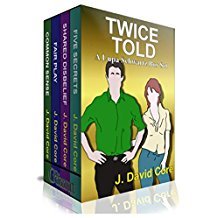
Twice Told, a Lupa Schwartz Box Set, gathers all of the Lupa Schwartz novels and novellas which have been released since the first. The series tells the story of Cattleya Hoskin, journalist for Gamut Magazine who moves from Ohio to Pittsburgh to chronicle the investigative cases of Lupa Schwartz, the outspoken PI with a love for women, classic cars, comedy movies, and good meat; and a strong disdain for religion, bad parking, and wasted time.
This box set contains all of the Lupa Schwartz novels and novellas which have been released since the first. The entire series; Extreme Unction, Common Sense, Fair Play, Shared Disbelief, and Five Secrets; tells the story of Cattleya Hoskin, journalist for Gamut Magazine who moves from Cleveland to Pittsburgh to chronicle the investigative caseload of Lupa Schwartz, the outspoken PI with a love for women, classic cars, comedy movies, and good meat; and a strong disdain for religion, bad parking, and wasted time. Book one, Extreme Unction, is available to read for free, so this set, which brings books two through five together in one place, makes owning the entire series easier than ever before.This sale is only available through Smashwords, but all eBook formats are available. Get you copy by visiting this link! You'll have to download the first book, Extreme Unction, separately, but it's FREE.
Use the code SEY75 at checkout for 75% off during the Smashwords site-wide promotion!

Published on December 25, 2017 08:40
November 23, 2017
Black Friday eBook Sale
Author Alexa Kang is hosting a fantastic Black Friday Sale featuring romance titles, holiday themed stories, and yes, mysteries and thrillers. You'll find all of the details on her site at alexakang.com/holiday99cbooksale/
FYI, my latest book, On the Side of the Angel, is also included in this sale. If you're worried that you opened this email a little too late, the sale continues through November 28th.

FYI, my latest book, On the Side of the Angel, is also included in this sale. If you're worried that you opened this email a little too late, the sale continues through November 28th.

Published on November 23, 2017 21:00
November 10, 2017
99 Cent eBooks!
I don't have a book in this one, but Renée Pawlish's monthly promo featuring 99¢ mystery and thriller eBooks is this weekend. Visit this link for nearly 40 titles each available for less than $1.
Published on November 10, 2017 21:00
November 5, 2017
Guest Post - Beyond Words by A.B. Plum
AB Plum grew up in Southern Missouri. She has lived in Mexico, Bolivia, and Argentina. After grad school, she taught adolescent boys, created public library programs, and honed her fiction-writing skills developing high-tech marketing materials.
 A six-month leave of absence to write fiction that entertains turned into a full-time career. PRINCE OF FROGS and QUEEN of the UNIVERSE, romantic comedies, were her first published novels. Two romantic suspense novels followed: PRESUMED GUILTY and UNRAVELED.
A six-month leave of absence to write fiction that entertains turned into a full-time career. PRINCE OF FROGS and QUEEN of the UNIVERSE, romantic comedies, were her first published novels. Two romantic suspense novels followed: PRESUMED GUILTY and UNRAVELED.
She now writes her passion—psychological suspense. Three novellas and three novels comprise her first series, THE MISfIT. Ever wonder about the twisted childhood of Hannibal Lector? Read the novellas and meet Michael Romanov—different, destructively different from birth.
Ever wonder about the pernicious influence of a grown-up misfit? Read the novels and follow the consequences of Michael Romanov’s conviction of his uniqueness.
AB lives just off the fast-lane in Silicon Valley with her husband. Reading, hiking, aerobic dancing, and participating in debates about hot-button topics propel her imagination toward murder.
She loves hearing from readers and getting their input. Contact her at ab@abplum.com.
From time to time, she makes special offers to fans (FREE books or a reader-author interview or an unpublished story or a behind-the-scenes clip). Learn more here.
STOP: Memoirists, playwrights, scriptwriters, poets, biographers, lyricists, journalists, academics, and all other non-novelists need read no further. The audience for these ramblings is fiction writers—real writers.
Why? Why real writers?
Because all those other writers (legitimate every one) can use photos, sets, actors, charts, music, figures and other devices rarely used in adult fiction. Novelists rely on one tool—words.
Words, some biologists and most people, believe separate us from all other animals. Yes, animals may emit whistles (whales) or yodels (coyotes) or meows (cats) or quacks (ducks) or buzzing (bees) or growls (bears, big cats, and badgers) or screeches (bats and some birds) or “songs” (birds). They may vocalize with their kind quite effectively. But … words. Words are reserved for us humans.
Most homo sapiens begin making recognizable words from early childhood. Babies’ first utterances
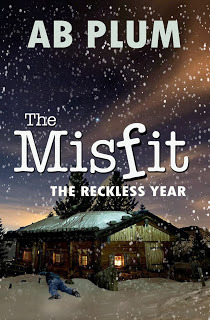 usually generate verbal expressions from parents of surprise, gratitude, and pride. It’s as if no one in the universe has ever accomplished such a deed. At the other end of life’s spectrum, words often escape the dying. Maybe by then we’ve used up all our words. Maybe we’re tired. Maybe we’re in pain. Maybe we just damned well don’t want to yammer about facing the Great Unknown.
usually generate verbal expressions from parents of surprise, gratitude, and pride. It’s as if no one in the universe has ever accomplished such a deed. At the other end of life’s spectrum, words often escape the dying. Maybe by then we’ve used up all our words. Maybe we’re tired. Maybe we’re in pain. Maybe we just damned well don’t want to yammer about facing the Great Unknown.
Many a novel has been writ on this subject.
We writers capture feelings and paint people, places, and things with the only concrete tool in our toolbox. We grab the reader’s imagination, opening up contradictory and complementary views of life.
We invent new worlds or resurrect old realms with a few well-placed syllables. We embroider fact and produce fiction.
We fabricate characters with originality and verve. We entertain, hoping no reader ever skims the precious words we’ve set down on the page. We elicit laughs and mine for tears. A few simple words in a well-developed story with unforgettable characters in a tough situation can transport and transform readers.
Storytelling lets us explore, extoll, and expand big questions with gusto or quiet restraint:
Why does a character commit murder? (Crime/Mystery/Suspense/Thriller)
How likely is “happiness ever after” between two humans? (Romance/Inspirational/Comedy)
How do we survive the death of a loved one? (Tragedy/Melodrama)
How can humans communicate with vampires/werewolves/zombies after the Apocalypse?
(Paranormal/Urban Fiction)
How will humans react meeting an ET in outer space? (SciFi)
How can guys who ride horses ever transition into modern society? (Westerns)
How can women look at their lives and families and find fulfillment? (Women’s Fiction)
Words are the common denominator. Sometimes they come with ease and fluency. Sometimes they elude us like fairy dust. Sometimes the words are fine, but we have to change the syntax. Too many sentences run together in dialogue (or narrative) reduce the power of the utterance and the eloquence of the written word. We can mangle grammar, but the result may confuse and lose the reader.
Confession: I am an unabashed logophile. Reading gets the credit. My parents weren’t educated—though my mother read and encouraged my reading—neither ever encouraged vocabulary building. Since I always read beyond my age level, I learned early to use the dictionary. Discovering a word I’d run across originated in Greek or Roman set my imagination on fire. Lavatory, for example, stemmed from lavare—which sounded so much more exotic than to wash. To this day, I love taking vocabulary quizzes and feeling smug when I tally my score. I often chase after the meaning of [un]common sayings like going to hell in a handbasket for fun. (Spectator sports rarely claim my attention).
Now having made my argument for words, I’m going to play devil’s advocate.
If allowed ten books during exile on a desert island, I would choose nine children’s picture books.
Not because of the words (usually few).
Because of the illustrations. They usually go beyond words on the page. The best ones are as powerful as words. The best ones speak volumes (an apt cliché, IMO) in a few pages. The best ones can make reading the story redundant. Notice the caveat “best.” Best makes the difference and often costs enough to reflect the quality that has gone into the illustrations. The picture books I’m talking about are works of art. They need no words. The drawings or paintings or mixed media speak.
I’ve recently discovered two children’s illustrated books to add to my collection of over a hundred titles.
Duck, Death and The Tulip by Wolf Erlbruch, an award-winning illustrator. In this case, he is also the author. He is well-known for collaborating on humorous picture books like The Story of the Little Mole Who Knew It Was None of His Business. The pictures tell you the story.
Cry Heart, But Never Break written by Glenn Ringtved and illustrated by Charlotte Pardi received the ALA 2017 Mildred L. Batchelder Award after its original Danish publication in 2002. The illustrations will etch Death into your imagination forever.
These two picture books have become go-to sources for reflection and inspiration in my own writing.
The MisFit Series follows the dark journey of a child psychopath. The words portray a bleak life, and sometimes I need a break. A variety of illustrations give me that break and the will to keep writing.
So, from one logophile to another, I highly recommend investing in a couple of quality picture books to go beyond the words you write. As Nicole Krauss says in The History of Love, "I’ve learned “… there isn’t a word for everything.”
 A six-month leave of absence to write fiction that entertains turned into a full-time career. PRINCE OF FROGS and QUEEN of the UNIVERSE, romantic comedies, were her first published novels. Two romantic suspense novels followed: PRESUMED GUILTY and UNRAVELED.
A six-month leave of absence to write fiction that entertains turned into a full-time career. PRINCE OF FROGS and QUEEN of the UNIVERSE, romantic comedies, were her first published novels. Two romantic suspense novels followed: PRESUMED GUILTY and UNRAVELED.She now writes her passion—psychological suspense. Three novellas and three novels comprise her first series, THE MISfIT. Ever wonder about the twisted childhood of Hannibal Lector? Read the novellas and meet Michael Romanov—different, destructively different from birth.
Ever wonder about the pernicious influence of a grown-up misfit? Read the novels and follow the consequences of Michael Romanov’s conviction of his uniqueness.
AB lives just off the fast-lane in Silicon Valley with her husband. Reading, hiking, aerobic dancing, and participating in debates about hot-button topics propel her imagination toward murder.
She loves hearing from readers and getting their input. Contact her at ab@abplum.com.
From time to time, she makes special offers to fans (FREE books or a reader-author interview or an unpublished story or a behind-the-scenes clip). Learn more here.
The Misfit: The Reckless Year (book 4)
A psychopath goes after what he wants and deserves…
Against all reason, ruthless Silicon Valley tycoon Michael Romanov, becomes infatuated with a totally unsuitable, but bewitching woman. Will he stop at murder to sweep her off her feet?
STOP: Memoirists, playwrights, scriptwriters, poets, biographers, lyricists, journalists, academics, and all other non-novelists need read no further. The audience for these ramblings is fiction writers—real writers.
Why? Why real writers?
Because all those other writers (legitimate every one) can use photos, sets, actors, charts, music, figures and other devices rarely used in adult fiction. Novelists rely on one tool—words.
Words, some biologists and most people, believe separate us from all other animals. Yes, animals may emit whistles (whales) or yodels (coyotes) or meows (cats) or quacks (ducks) or buzzing (bees) or growls (bears, big cats, and badgers) or screeches (bats and some birds) or “songs” (birds). They may vocalize with their kind quite effectively. But … words. Words are reserved for us humans.
Most homo sapiens begin making recognizable words from early childhood. Babies’ first utterances
 usually generate verbal expressions from parents of surprise, gratitude, and pride. It’s as if no one in the universe has ever accomplished such a deed. At the other end of life’s spectrum, words often escape the dying. Maybe by then we’ve used up all our words. Maybe we’re tired. Maybe we’re in pain. Maybe we just damned well don’t want to yammer about facing the Great Unknown.
usually generate verbal expressions from parents of surprise, gratitude, and pride. It’s as if no one in the universe has ever accomplished such a deed. At the other end of life’s spectrum, words often escape the dying. Maybe by then we’ve used up all our words. Maybe we’re tired. Maybe we’re in pain. Maybe we just damned well don’t want to yammer about facing the Great Unknown.Many a novel has been writ on this subject.
We writers capture feelings and paint people, places, and things with the only concrete tool in our toolbox. We grab the reader’s imagination, opening up contradictory and complementary views of life.
We invent new worlds or resurrect old realms with a few well-placed syllables. We embroider fact and produce fiction.
We fabricate characters with originality and verve. We entertain, hoping no reader ever skims the precious words we’ve set down on the page. We elicit laughs and mine for tears. A few simple words in a well-developed story with unforgettable characters in a tough situation can transport and transform readers.
Storytelling lets us explore, extoll, and expand big questions with gusto or quiet restraint:
Why does a character commit murder? (Crime/Mystery/Suspense/Thriller)
How likely is “happiness ever after” between two humans? (Romance/Inspirational/Comedy)
How do we survive the death of a loved one? (Tragedy/Melodrama)
How can humans communicate with vampires/werewolves/zombies after the Apocalypse?
(Paranormal/Urban Fiction)
How will humans react meeting an ET in outer space? (SciFi)
How can guys who ride horses ever transition into modern society? (Westerns)
How can women look at their lives and families and find fulfillment? (Women’s Fiction)
Words are the common denominator. Sometimes they come with ease and fluency. Sometimes they elude us like fairy dust. Sometimes the words are fine, but we have to change the syntax. Too many sentences run together in dialogue (or narrative) reduce the power of the utterance and the eloquence of the written word. We can mangle grammar, but the result may confuse and lose the reader.
Confession: I am an unabashed logophile. Reading gets the credit. My parents weren’t educated—though my mother read and encouraged my reading—neither ever encouraged vocabulary building. Since I always read beyond my age level, I learned early to use the dictionary. Discovering a word I’d run across originated in Greek or Roman set my imagination on fire. Lavatory, for example, stemmed from lavare—which sounded so much more exotic than to wash. To this day, I love taking vocabulary quizzes and feeling smug when I tally my score. I often chase after the meaning of [un]common sayings like going to hell in a handbasket for fun. (Spectator sports rarely claim my attention).
Now having made my argument for words, I’m going to play devil’s advocate.
If allowed ten books during exile on a desert island, I would choose nine children’s picture books.
Not because of the words (usually few).
Because of the illustrations. They usually go beyond words on the page. The best ones are as powerful as words. The best ones speak volumes (an apt cliché, IMO) in a few pages. The best ones can make reading the story redundant. Notice the caveat “best.” Best makes the difference and often costs enough to reflect the quality that has gone into the illustrations. The picture books I’m talking about are works of art. They need no words. The drawings or paintings or mixed media speak.
I’ve recently discovered two children’s illustrated books to add to my collection of over a hundred titles.
Duck, Death and The Tulip by Wolf Erlbruch, an award-winning illustrator. In this case, he is also the author. He is well-known for collaborating on humorous picture books like The Story of the Little Mole Who Knew It Was None of His Business. The pictures tell you the story.
Cry Heart, But Never Break written by Glenn Ringtved and illustrated by Charlotte Pardi received the ALA 2017 Mildred L. Batchelder Award after its original Danish publication in 2002. The illustrations will etch Death into your imagination forever.
These two picture books have become go-to sources for reflection and inspiration in my own writing.
The MisFit Series follows the dark journey of a child psychopath. The words portray a bleak life, and sometimes I need a break. A variety of illustrations give me that break and the will to keep writing.
So, from one logophile to another, I highly recommend investing in a couple of quality picture books to go beyond the words you write. As Nicole Krauss says in The History of Love, "I’ve learned “… there isn’t a word for everything.”
Published on November 05, 2017 22:32
Guest Blog Post - Beyond Words by A.B. Plum
AB Plum grew up in Southern Missouri. She has lived in Mexico, Bolivia, and Argentina. After grad school, she taught adolescent boys, created public library programs, and honed her fiction-writing skills developing high-tech marketing materials.
 A six-month leave of absence to write fiction that entertains turned into a full-time career. PRINCE OF FROGS and QUEEN of the UNIVERSE, romantic comedies, were her first published novels. Two romantic suspense novels followed: PRESUMED GUILTY and UNRAVELED.
A six-month leave of absence to write fiction that entertains turned into a full-time career. PRINCE OF FROGS and QUEEN of the UNIVERSE, romantic comedies, were her first published novels. Two romantic suspense novels followed: PRESUMED GUILTY and UNRAVELED.
She now writes her passion—psychological suspense. Three novellas and three novels comprise her first series, THE MISfIT. Ever wonder about the twisted childhood of Hannibal Lector? Read the novellas and meet Michael Romanov—different, destructively different from birth.
Ever wonder about the pernicious influence of a grown-up misfit? Read the novels and follow the consequences of Michael Romanov’s conviction of his uniqueness.
AB lives just off the fast-lane in Silicon Valley with her husband. Reading, hiking, aerobic dancing, and participating in debates about hot-button topics propel her imagination toward murder.
She loves hearing from readers and getting their input. Contact her at ab@abplum.com.
From time to time, she makes special offers to fans (FREE books or a reader-author interview or an unpublished story or a behind-the-scenes clip). Learn more here.
STOP: Memoirists, playwrights, scriptwriters, poets, biographers, lyricists, journalists, academics, and all other non-novelists need read no further. The audience for these ramblings is fiction writers—real writers.
Why? Why real writers?
Because all those other writers (legitimate every one) can use photos, sets, actors, charts, music, figures and other devices rarely used in adult fiction. Novelists rely on one tool—words.
Words, some biologists and most people, believe separate us from all other animals. Yes, animals may emit whistles (whales) or yodels (coyotes) or meows (cats) or quacks (ducks) or buzzing (bees) or growls (bears, big cats, and badgers) or screeches (bats and some birds) or “songs” (birds). They may vocalize with their kind quite effectively. But … words. Words are reserved for us humans.
Most homo sapiens begin making recognizable words from early childhood. Babies’ first utterances
 usually generate verbal expressions from parents of surprise, gratitude, and pride. It’s as if no one in the universe has ever accomplished such a deed. At the other end of life’s spectrum, words often escape the dying. Maybe by then we’ve used up all our words. Maybe we’re tired. Maybe we’re in pain. Maybe we just damned well don’t want to yammer about facing the Great Unknown.
usually generate verbal expressions from parents of surprise, gratitude, and pride. It’s as if no one in the universe has ever accomplished such a deed. At the other end of life’s spectrum, words often escape the dying. Maybe by then we’ve used up all our words. Maybe we’re tired. Maybe we’re in pain. Maybe we just damned well don’t want to yammer about facing the Great Unknown.
Many a novel has been writ on this subject.
We writers capture feelings and paint people, places, and things with the only concrete tool in our
toolbox. We grab the reader’s imagination, opening up contradictory and complementary views of life.
We invent new worlds or resurrect old realms with a few well-placed syllables. We embroider fact and produce fiction.
We fabricate characters with originality and verve. We entertain, hoping no reader ever skims the
precious words we’ve set down on the page. We elicit laughs and mine for tears. A few simple words in a well-developed story with unforgettable characters in a tough situation can transport and transform readers.
Storytelling lets us explore, extoll, and expand big questions with gusto or quiet restraint:
Why does a character commit murder? (Crime/Mystery/Suspense/Thriller)
How likely is “happiness ever after” between two humans? (Romance/Inspirational/Comedy)
How do we survive the death of a loved one? (Tragedy/Melodrama)
How can humans communicate with vampires/werewolves/zombies after the Apocalypse?
(Paranormal/Urban Fiction)
How will humans react meeting an ET in outer space? (SciFi)
How can guys who ride horses ever transition into modern society? (Westerns)
How can women look at their lives and families and find fulfillment? (Women’s Fiction)
Words are the common denominator. Sometimes they come with ease and fluency. Sometimes they
elude us like fairy dust. Sometimes the words are fine, but we have to change the syntax. Too many
sentences run together in dialogue (or narrative) reduce the power of the utterance and the eloquence
of the written word. We can mangle grammar, but the result may confuse and lose the reader.
Confession: I am an unabashed logophile. Reading gets the credit. My parents weren’t
educated—though my mother read and encouraged my reading—neither ever encouraged vocabulary
building. Since I always read beyond my age level, I learned early to use the dictionary. Discovering a word I’d run across originated in Greek or Roman set my imagination on fire. Lavatory, for example, stemmed from lavare—which sounded so much more exotic than to wash. To this day, I love taking vocabulary quizzes and feeling smug when I tally my score. I often chase after the meaning of [un]common sayings like going to hell in a handbasket for fun. (Spectator sports rarely claim my attention).
Now having made my argument for words, I’m going to play devil’s advocate.
If allowed ten books during exile on a desert island, I would choose nine children’s picture books.
Not because of the words (usually few).
Because of the illustrations. They usually go beyond words on the page. The best ones are as powerful as words. The best ones speak volumes (an apt cliché, IMO) in a few pages. The best ones can make reading the story redundant. Notice the caveat “best.” Best makes the difference and often costs enough to reflect the quality that has gone into the illustrations. The picture books I’m talking about are works of art. They need no words. The drawings or paintings or mixed media speak.
I’ve recently discovered two children’s illustrated books to add to my collection of over a hundred titles.
Duck, Death and The Tulip by Wolf Erlbruch, an award-winning illustrator. In this case, he is also the author. He is well-known for collaborating on humorous picture books like The Story of the Little Mole Who Knew It Was None of His Business. The pictures tell you the story.
Cry Heart, But Never Break written by Glenn Ringtved and illustrated by Charlotte Pardi received the ALA 2017 Mildred L. Batchelder Award after its original Danish publication in 2002. The illustrations will etch Death into your imagination forever.
These two picture books have become go-to sources for reflection and inspiration in my own writing.
The MisFit Series follows the dark journey of a child psychopath. The words portray a bleak life, and sometimes I need a break. A variety of illustrations give me that break and the will to keep writing.
So, from one logophile to another, I highly recommend investing in a couple of quality picture books to go beyond the words you write. As Nicole Krauss says in The History of Love, "I’ve learned “… there isn’t a word for everything.”
 A six-month leave of absence to write fiction that entertains turned into a full-time career. PRINCE OF FROGS and QUEEN of the UNIVERSE, romantic comedies, were her first published novels. Two romantic suspense novels followed: PRESUMED GUILTY and UNRAVELED.
A six-month leave of absence to write fiction that entertains turned into a full-time career. PRINCE OF FROGS and QUEEN of the UNIVERSE, romantic comedies, were her first published novels. Two romantic suspense novels followed: PRESUMED GUILTY and UNRAVELED.She now writes her passion—psychological suspense. Three novellas and three novels comprise her first series, THE MISfIT. Ever wonder about the twisted childhood of Hannibal Lector? Read the novellas and meet Michael Romanov—different, destructively different from birth.
Ever wonder about the pernicious influence of a grown-up misfit? Read the novels and follow the consequences of Michael Romanov’s conviction of his uniqueness.
AB lives just off the fast-lane in Silicon Valley with her husband. Reading, hiking, aerobic dancing, and participating in debates about hot-button topics propel her imagination toward murder.
She loves hearing from readers and getting their input. Contact her at ab@abplum.com.
From time to time, she makes special offers to fans (FREE books or a reader-author interview or an unpublished story or a behind-the-scenes clip). Learn more here.
The Misfit: The Reckless Year (book 4)
A psychopath goes after what he wants and deserves…
Against all reason, ruthless Silicon Valley tycoon Michael Romanov, becomes infatuated with a totally unsuitable, but bewitching woman. Will he stop at murder to sweep her off her feet?
STOP: Memoirists, playwrights, scriptwriters, poets, biographers, lyricists, journalists, academics, and all other non-novelists need read no further. The audience for these ramblings is fiction writers—real writers.
Why? Why real writers?
Because all those other writers (legitimate every one) can use photos, sets, actors, charts, music, figures and other devices rarely used in adult fiction. Novelists rely on one tool—words.
Words, some biologists and most people, believe separate us from all other animals. Yes, animals may emit whistles (whales) or yodels (coyotes) or meows (cats) or quacks (ducks) or buzzing (bees) or growls (bears, big cats, and badgers) or screeches (bats and some birds) or “songs” (birds). They may vocalize with their kind quite effectively. But … words. Words are reserved for us humans.
Most homo sapiens begin making recognizable words from early childhood. Babies’ first utterances
 usually generate verbal expressions from parents of surprise, gratitude, and pride. It’s as if no one in the universe has ever accomplished such a deed. At the other end of life’s spectrum, words often escape the dying. Maybe by then we’ve used up all our words. Maybe we’re tired. Maybe we’re in pain. Maybe we just damned well don’t want to yammer about facing the Great Unknown.
usually generate verbal expressions from parents of surprise, gratitude, and pride. It’s as if no one in the universe has ever accomplished such a deed. At the other end of life’s spectrum, words often escape the dying. Maybe by then we’ve used up all our words. Maybe we’re tired. Maybe we’re in pain. Maybe we just damned well don’t want to yammer about facing the Great Unknown.Many a novel has been writ on this subject.
We writers capture feelings and paint people, places, and things with the only concrete tool in our
toolbox. We grab the reader’s imagination, opening up contradictory and complementary views of life.
We invent new worlds or resurrect old realms with a few well-placed syllables. We embroider fact and produce fiction.
We fabricate characters with originality and verve. We entertain, hoping no reader ever skims the
precious words we’ve set down on the page. We elicit laughs and mine for tears. A few simple words in a well-developed story with unforgettable characters in a tough situation can transport and transform readers.
Storytelling lets us explore, extoll, and expand big questions with gusto or quiet restraint:
Why does a character commit murder? (Crime/Mystery/Suspense/Thriller)
How likely is “happiness ever after” between two humans? (Romance/Inspirational/Comedy)
How do we survive the death of a loved one? (Tragedy/Melodrama)
How can humans communicate with vampires/werewolves/zombies after the Apocalypse?
(Paranormal/Urban Fiction)
How will humans react meeting an ET in outer space? (SciFi)
How can guys who ride horses ever transition into modern society? (Westerns)
How can women look at their lives and families and find fulfillment? (Women’s Fiction)
Words are the common denominator. Sometimes they come with ease and fluency. Sometimes they
elude us like fairy dust. Sometimes the words are fine, but we have to change the syntax. Too many
sentences run together in dialogue (or narrative) reduce the power of the utterance and the eloquence
of the written word. We can mangle grammar, but the result may confuse and lose the reader.
Confession: I am an unabashed logophile. Reading gets the credit. My parents weren’t
educated—though my mother read and encouraged my reading—neither ever encouraged vocabulary
building. Since I always read beyond my age level, I learned early to use the dictionary. Discovering a word I’d run across originated in Greek or Roman set my imagination on fire. Lavatory, for example, stemmed from lavare—which sounded so much more exotic than to wash. To this day, I love taking vocabulary quizzes and feeling smug when I tally my score. I often chase after the meaning of [un]common sayings like going to hell in a handbasket for fun. (Spectator sports rarely claim my attention).
Now having made my argument for words, I’m going to play devil’s advocate.
If allowed ten books during exile on a desert island, I would choose nine children’s picture books.
Not because of the words (usually few).
Because of the illustrations. They usually go beyond words on the page. The best ones are as powerful as words. The best ones speak volumes (an apt cliché, IMO) in a few pages. The best ones can make reading the story redundant. Notice the caveat “best.” Best makes the difference and often costs enough to reflect the quality that has gone into the illustrations. The picture books I’m talking about are works of art. They need no words. The drawings or paintings or mixed media speak.
I’ve recently discovered two children’s illustrated books to add to my collection of over a hundred titles.
Duck, Death and The Tulip by Wolf Erlbruch, an award-winning illustrator. In this case, he is also the author. He is well-known for collaborating on humorous picture books like The Story of the Little Mole Who Knew It Was None of His Business. The pictures tell you the story.
Cry Heart, But Never Break written by Glenn Ringtved and illustrated by Charlotte Pardi received the ALA 2017 Mildred L. Batchelder Award after its original Danish publication in 2002. The illustrations will etch Death into your imagination forever.
These two picture books have become go-to sources for reflection and inspiration in my own writing.
The MisFit Series follows the dark journey of a child psychopath. The words portray a bleak life, and sometimes I need a break. A variety of illustrations give me that break and the will to keep writing.
So, from one logophile to another, I highly recommend investing in a couple of quality picture books to go beyond the words you write. As Nicole Krauss says in The History of Love, "I’ve learned “… there isn’t a word for everything.”
Published on November 05, 2017 22:32
October 13, 2017
Time for FREE Thrills
October is always a good time for a good thrill, and Renée Pawlish has your back. This month, her site is featuring twenty mystery and thriller eBook titles which you can snag for free. Whether you prefer cozies, shoot-em-ups, psychological thrillers, procedurals, or something in between, you're sure to find something you'll like to chill your bones this season. Check out the promo this weekend only at reneepawlish.com/promo.
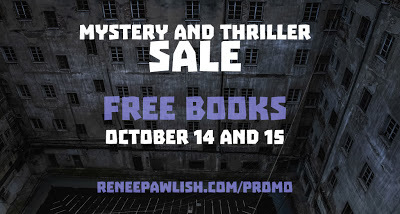
PS, on a personal note, I am the featured interview this week on author JD Byrne's website. Check it out here, and enjoy!

PS, on a personal note, I am the featured interview this week on author JD Byrne's website. Check it out here, and enjoy!
Published on October 13, 2017 09:42
September 23, 2017
A Special Offer for Paper Book Lovers
 I've run several special deals for eBook readers on my Lupa Schwartz mystery novel series. However, I have never run a price break special on the paperbacks of this series ... until now.
I've run several special deals for eBook readers on my Lupa Schwartz mystery novel series. However, I have never run a price break special on the paperbacks of this series ... until now.Follow this link to a special page where you will find all of the titles and links as well as a promotional code to get each title at 20% off the cover price when you buy direct from the CreateSpace Print on Demand store. Order any one copy and get it for 80% of what it normally costs or get the entire series and save on shipping.

Published on September 23, 2017 22:50
September 20, 2017
Free Thrills for September
I am going to be involved in a brand new Instafreebie giveaway running September 21st to the 30th. This one is organized by Eugene Lloyd MacRae. The promo features over 20 titles, all of which you can download for free in exchange for signing up to the author's email list. Once the program goes live, you can find it by clicking here.
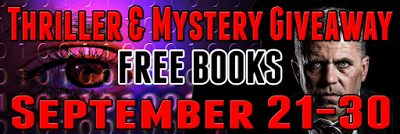

Published on September 20, 2017 21:00
September 15, 2017
Team Mystery Thriller September Promo
This month's mystery and thriller promo hosted by the amazing Renée Pawlish is 99¢ eBooks. All of the titles can be found at ReneePawlish.com/Promo, and every title can be had for less than $1 each. The promo is Amazon only, but the title I am featuring is my latest release, On the Side of the Angel, which just came out of the Zon's exclusive Kindle Select program and is therefore available in wide release for the same low price of 99¢.
So if you use Amazon and haven't picked up a copy yet, click on over to Renée's website and pick up a copy, then grab a few other titles while you're there. If you do not use Amazon, find a copy at your favorite Online retailer here.

So if you use Amazon and haven't picked up a copy yet, click on over to Renée's website and pick up a copy, then grab a few other titles while you're there. If you do not use Amazon, find a copy at your favorite Online retailer here.

Published on September 15, 2017 21:12
September 7, 2017
I need a favor
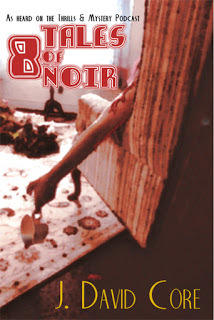 If you've listened to and enjoyed any of the episodes of my podcast, you've probably heard at least a few of the episodes featuring some of my stories. A little over a year ago, I released a print and eBook collection of several of those stories called 8 Tales of Noir. The book features six short stories and two novellas. Well, I am currently assembling those episodes into an audio book version of that publication, but the eBook is still languishing with zero reviews. So I have a request.
If you've listened to and enjoyed any of the episodes of my podcast, you've probably heard at least a few of the episodes featuring some of my stories. A little over a year ago, I released a print and eBook collection of several of those stories called 8 Tales of Noir. The book features six short stories and two novellas. Well, I am currently assembling those episodes into an audio book version of that publication, but the eBook is still languishing with zero reviews. So I have a request.Could you please take a moment to visit the eBook's page on your choice of retailers' websites and post a review any of the stories you may have heard or post one for the whole book? In fact, to make it easy for you, I have compiled playlists of the specific episodes featuring the stories from the book.
This link will take you to the playlist for the first six short stories. This link will take you to the playlist for the first novella in the book, Confessions of the Cuckold. Finally, this playlist features all of the episodes for the last novella in the book, Wingman. At the bottom of each playlist you will find this direct link to a page where you can find the book on any retailer of your choice.
Getting reviews is difficult, but you've heard he stories so you know if you liked them. Let others know. It'll help them, and it will absolutely help me.
Thanks so much. You're great!
Published on September 07, 2017 22:15



